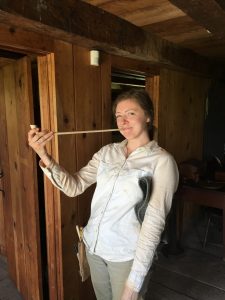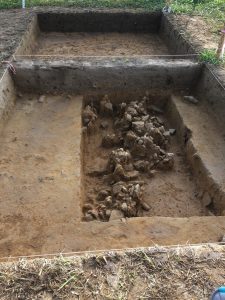By: Heather MacIsaac and Kristina Gaugler, Field School Supervisors

Heather works with Karlena and Marina to identify soil colors with a Munsell book. (Photo credit: Dr. Ben Ford).
Between July 18th and August 18th, I had the privilege of training and working with eleven IUP students at Hanna’s Town. Most of these students had no prior experience with excavation, arriving on the first day armed with sunblock, lunches, and a willingness to learn as much about fieldwork as they could.
Under guidance from Dr. Ben Ford and Dr. Bill Chadwick, the students set up six excavation units. The professors selected the areas for units based on the preliminary results of a geophysical survey conducted by graduate student David Breitkreutz. Geophysics benefits archaeologists by highlighting things below ground which may be the remnants of former human activity – houses, roads, fireplaces, burials – but is not precise enough to reveal exactly what lies under the surface. Field school students excavated in areas where Breitkreutz’s survey results pointed to buried circular patterns and a long, thick stripe that cut across the empty field near the reconstructed Hanna’s Town Fort. Were these subterranean shapes colonial era hearths or Native American round houses, and could the stripe be the original Forbes Road, the main street of the Hanna’s Town settlement? Only excavation could answer those questions.
My own first experience with digging took place during my sophomore year of undergrad at the site of a 19th century observatory in Wisconsin. As luck would have it, the first few weeks of digging produced nothing but rocks, but at some point the rocks appeared less and less in the excavation unit and were replaced by broken lab equipment, early lightbulbs, and even pieces of neon-painted pottery from when the observatory turned into a hip young poets’ club in the 1960s before the building was demolished. As I worked with students this summer, I found myself envious from time to time of the quality of the equipment available to them: canopies for shade, rain-proof field journals, binders for paperwork, and a fully working digital total station!
It was incredible watching the students gain confidence in their abilities, to see them face and overcome challenges each day, and to take ownership of their work and knowledge when visited by the public, tour guides, county reps, and other professors. While things didn’t always go as planned (i.e. flooded units or runaway notes), everyone had a good time at field school. Excavation uncovered the remains of wagon ruts and campfires, part of a large but yet unidentified stone structure, and a possible storage space for a prehistoric Native American house, all things which will prompt future research and a continued interest among students and visitors alike in Pennsylvania’s history.
-Heather

Working hard or hardly working? Kristina decided to spend break exploring reconstructed cabins at Hanna’s Town. (Photo credit: Heather MacIsaac)
On July 12th, 2017 I visited Hanna’s Town prior to the start of fieldwork to help get the site ready in preparation for their arrival. Coincidentally, almost exactly two hundred and thirty-five years earlier from that day, on July 13th, 1782, Hanna’s Town was attacked and burned to the ground by a force of Seneca and British soldiers. Fortunately, this ominous coincidence was not foreshadowing of the peril to come. In fact, short of a few rain storms, our entire field season was quite pleasant.
Using the established Hanna’s Town site grid, we located the six test units we would be excavating. Ten of the eleven participating students were split into pairs and assigned to a test unit. The eleventh student, Brennan Winzer, also a graduate student at IUP, was actually doing his own field work in a separate area of the site, although he had help from a rotating set of our students daily. The units were laid out in 5ft x 5ft squares (at historic sites we typically don’t use the metric system!) and after discussing the finer points of excavation techniques, we began digging. It is important to note, that across the Hanna’s Town site there is a layer of soil disturbance due to years of plowing. Therefore, the artifacts that come out of these upper most levels are likely not in situ. Indeed, all

A view of a stone feature that extended into the next unit. It is unknown if it is part of a historic or prehistoric structure. (Photo credit: Heather MacIsaac)
of the test units that I was personally responsible for supervising had large visible plow scars and/or mixed top soils, and the features we encountered were primarily located at the interface between the plow zone and the subsoil, the tops of them likely removed by plowing.
Throughout our excavations, there were some particularly interesting features, and a few of them would definitely benefit from further study. There was a semicircular ring of post molds in a test unit west of the reconstructed fort. Although no artifacts were associated with this feature, it’s appearance suggested that it could possibly represents the border of a Native American structure, probably prior to the Hanna’s Town occupation. In our trench unit, there appeared to be a wagon rut, in what we hope was the remnant of a long searched for road. A few interesting artifacts were discovered near this feature, including what seemed to be a two tined fork. My favorite feature at the site was located within two adjacent units. A large pile of burnt rocks, showing visible heat induced cracks, reddening and spalls, were lying in what appeared to be two straight(ish) interconnected lines. It is still unclear what this feature is, in part because we found no artifacts in association with it.
In 2009 I completed my own first field school at Kincaid Mounds in Illinois. A few years later, while working as a field and lab technician, I would often muse over the things that I wished I could share, or advice I would give, to students who were planning on entering this field. Fast forward to me supervising this field school, and I am so glad that I had the opportunity to get to do just that. It was great sharing my experience with students new to field work. They say that teaching is sometimes the best way to learn. I definitely felt that together, we all became better archaeologists, and at the same time learned more about the history of a very interesting site in western Pennsylvania.
-Kristina

